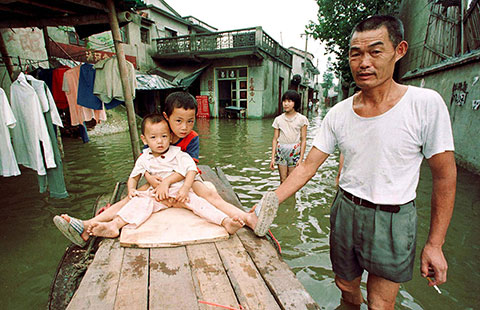Resort owner faces huge losses from flood
By LIU KUN/HOU LIQIANG (China Daily) Updated: 2016-07-16 07:13Wang Youlin drove his boat back and forth on Friday, his eyes fixed on a rural resort that he had been running for more than six years and that was now mostly submerged.
On Thursday, a dike between Liangzi and Niushan lakes in Wuhan was blown up to disperse surging floodwaters that had been above its highest safety level. After the explosion, about 50 million cubic meters of water flowed from Liangzi to Niushan, submerging an area of 25 square kilometers, including Wang's resort. The Hubei provincial government said that submerged areas would be permanently restored to lakes.
Wang, 57, is one of 1,658 people evacuated from the flooded area.
"There are some other restaurants near my resort and also some orchards," Wang said.
While some villagers were able to move their belongings out, Wang is not among the lucky ones. "There are too many things in my resort. I didn't have time to move all of them out," said Wang.
While people can choose to live in free accommodation offered by the government, some have chosen to rent homes or live with relatives. The Wuhan government has started to build houses to relocate those evacuated, and the first group of 542 will get their new homes in September.
For Wang and the many other people who will be displaced as more low-lying areas are used for floodwaters retention, how they will be compensated is still unclear.
While a compensation mechanism was established in 2008 in the Yellow River basin for economic losses in areas used for floodwaters retention, there is no such mechanism in the Yangtze River basin," said Chen Min, director of the Yangtze River Flood Control and Drought Relief Office under the Changjiang Water Resources Commission.
Chen also called for flood insurance in areas with flood risk, as the high losses from a flood may push victims into poverty overnight.
Contact the writer at houliqiang@chinadaily.com.cn
- Talks are key to resolving disputes, says Vietnam
- Sovereignty of China is 'bottom line'
- Young job seekers hope to find fame
- Wuhan merges 2 lakes to help fight flooding
- Air defense zone over South China Sea an option
- Li vows transparent, fair environment for European investors
- China calls on US, Japan to stop twisting the facts
- Two Nansha islands greet their first civil flights
- Flight-tests check routes to Nansha airfields
- Premier to set new course in Mongolia









